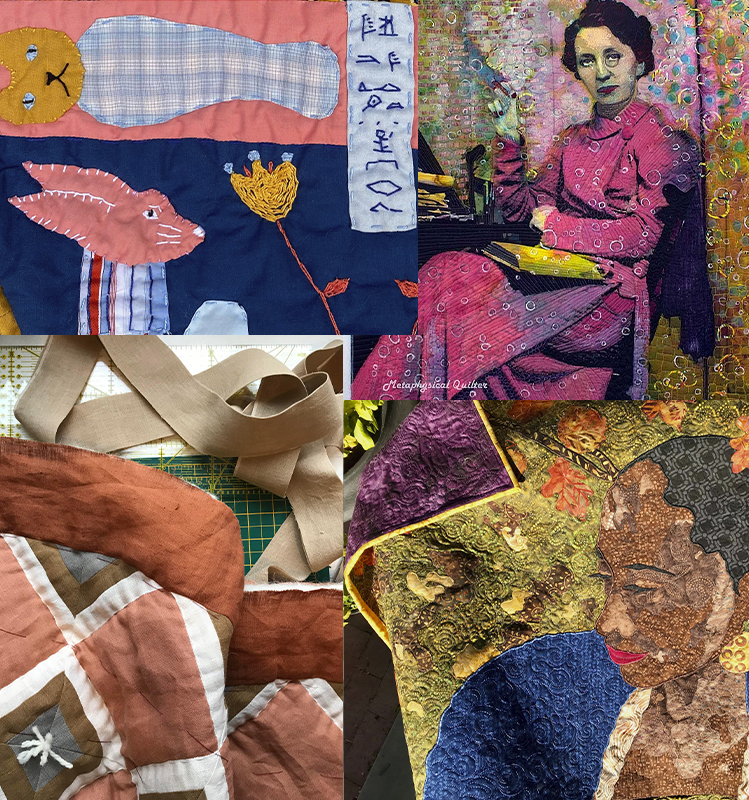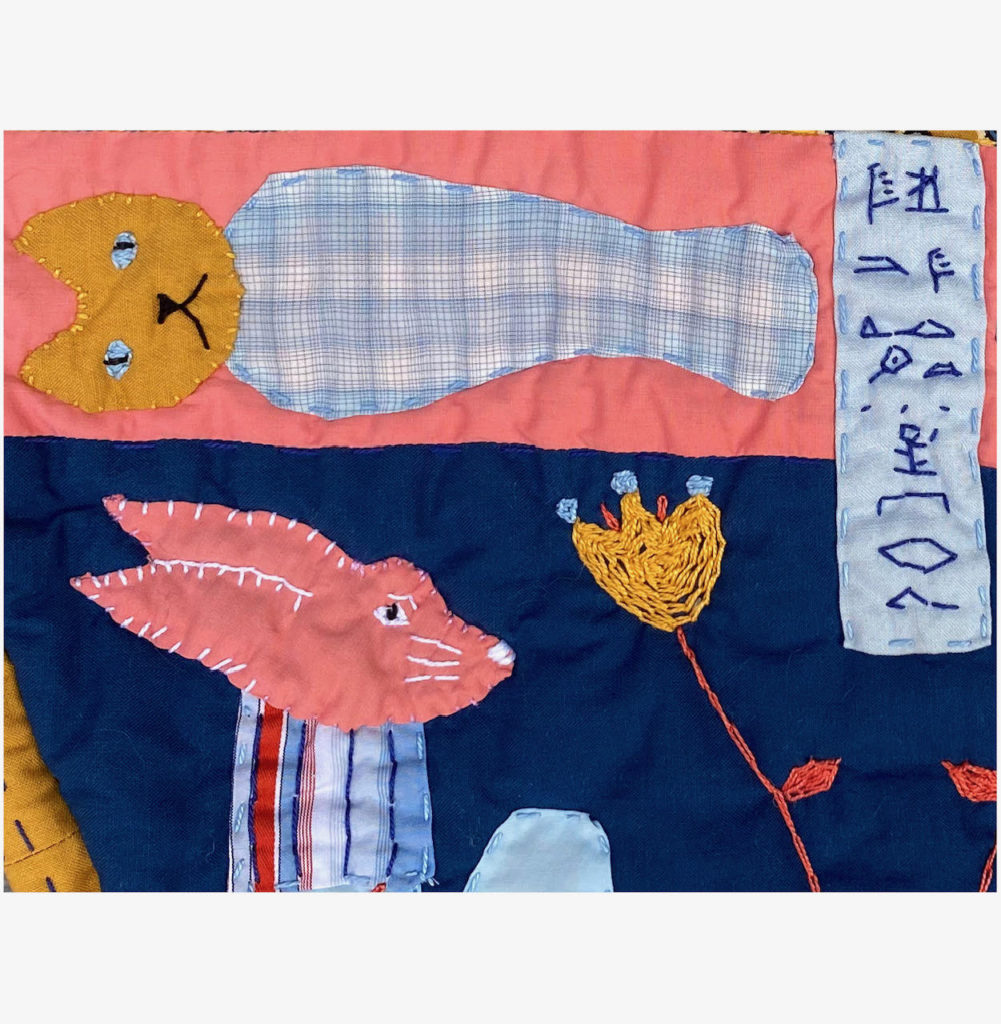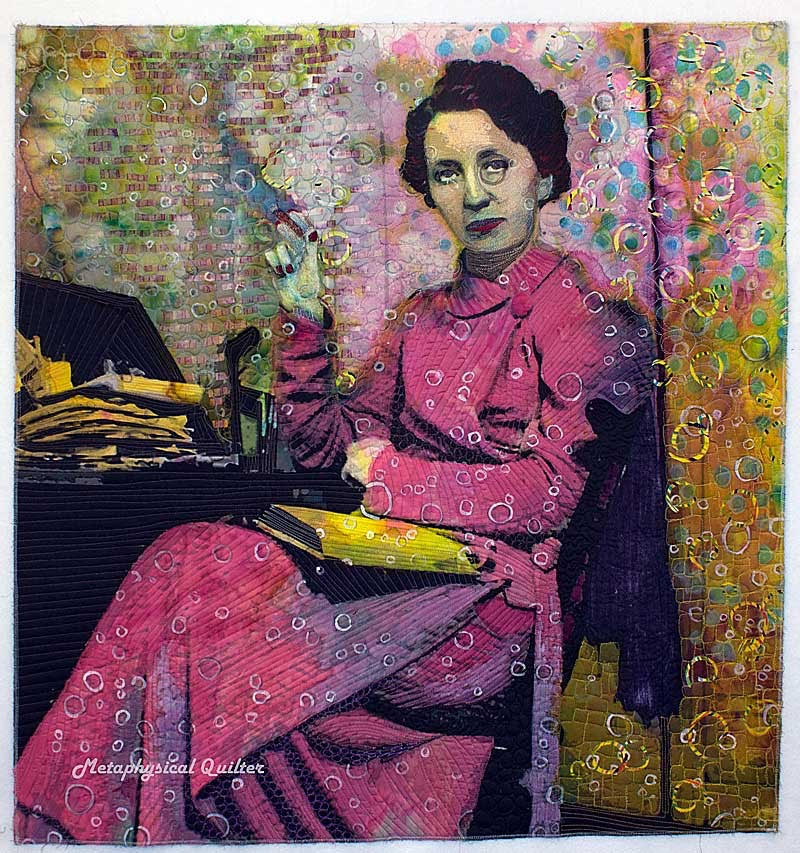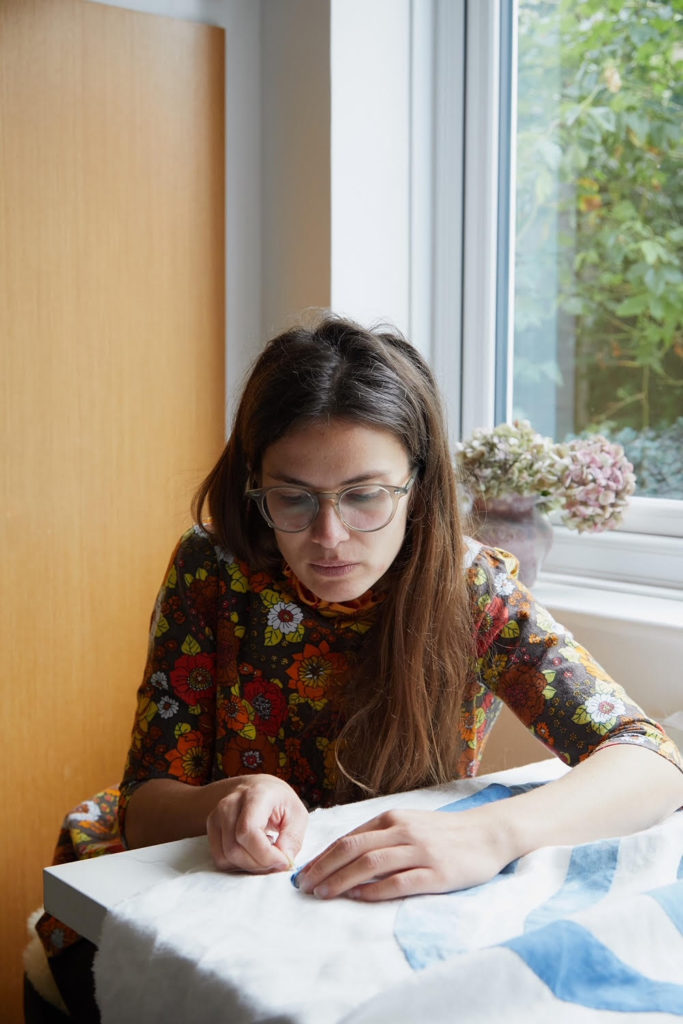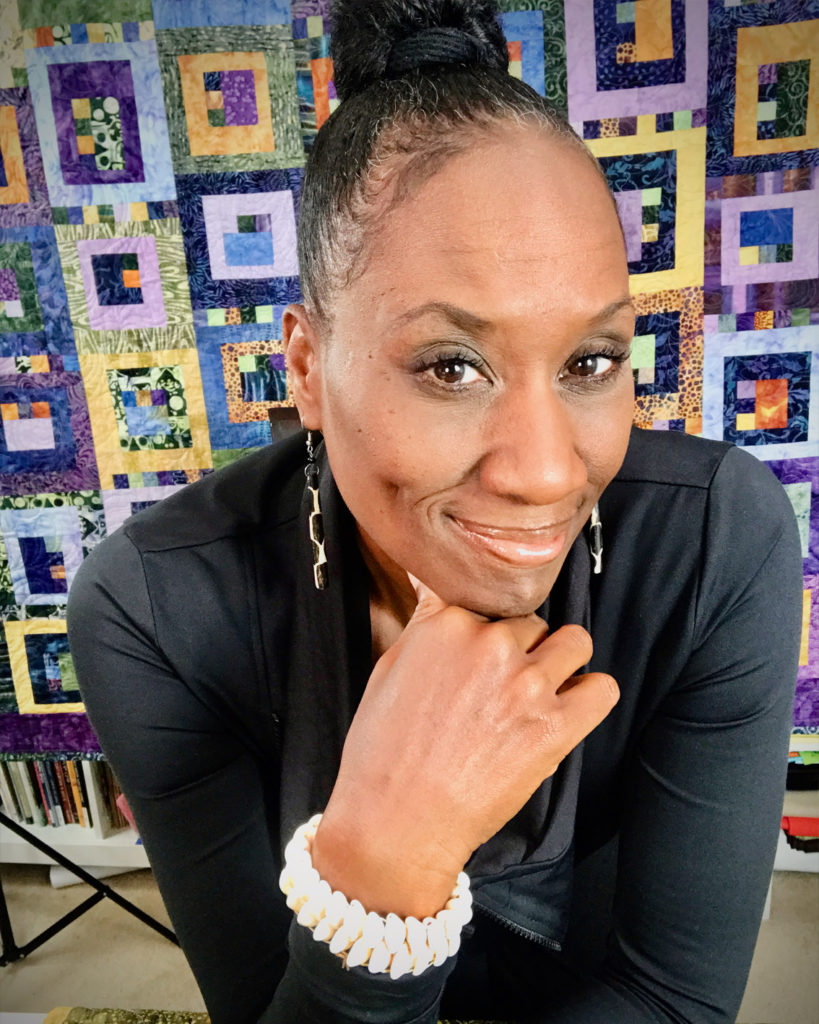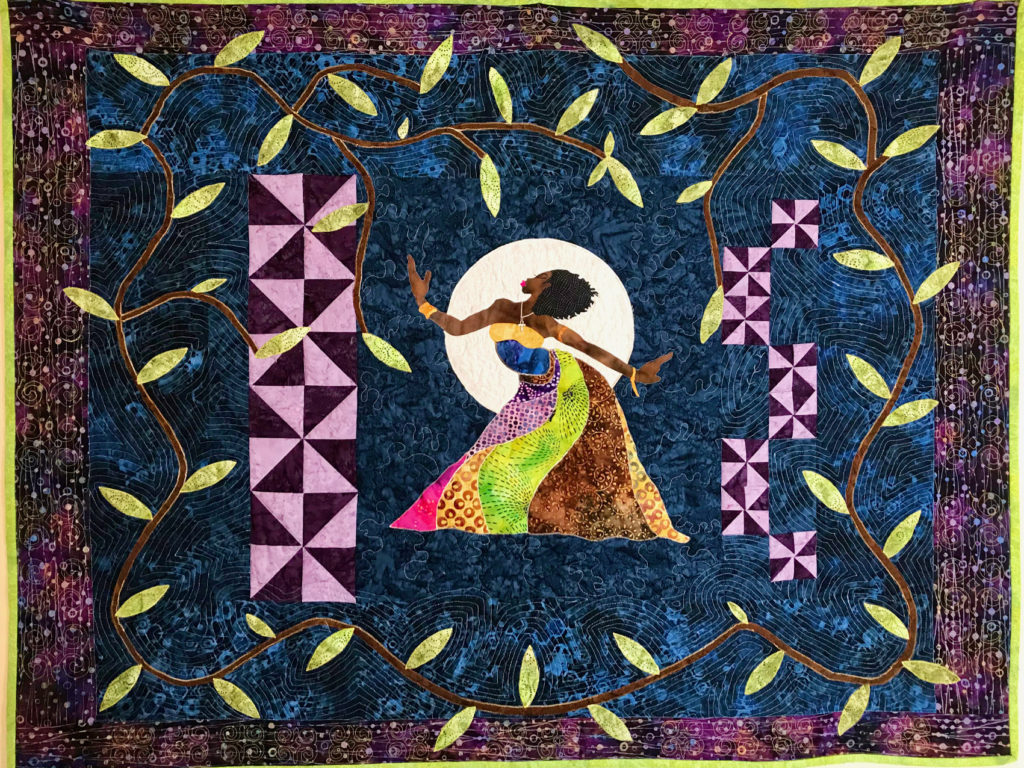In this new showcase I’m featuring four Modern Quilters that you will love!
Sabine Heinlein
My work can be lighthearted and humorous, but it also revels in dark thoughts. My quilts explore the sense of wonder that animals elicit while reminding us of the dangers both animals and humans face due to their abuse and extinction. I like to appeal to powerful human emotions, our need for friendship, intimacy and historic continuity. Because of the time and solitude that traditional hand-quilting demands, my work differs from the impersonal manufacturing process and the focus on spectacle that currently rule so much contemporary art.
Made from recycled textiles, my work challenges antiquated power structures, species inequality and our obsession with fast fashion. It confronts a consumerist culture that drives excessive energy and water consumption, causing diseases and environmental destruction.
I sewed the Zoonotic Disease Quilt (see portrait background) and the Egyptian Coffin Quilt during the first year of the Covid pandemic. The zoonotic “baby” quilt features 16 adorable animals and the diseases they transmit to humans. It asks: Would you want to cover your child with it, despite its “contagious” nature? Are you willing to recognize the destructive cycle that causes zoonotic diseases due to the abuse of animals and natural resources?
The Egyptian Coffin Quilt memorializes the millions of lives lost to Covid. Most people died alone, with no loved ones to comfort them. The quilt’s imagery is inspired by the Egyptian Book of the Dead, which, in ancient Egypt, was added to coffins to tell the deceased how to behave in the land of the dead and ensure a smooth transition to paradise. Constructed to fit an adult, it resembles a baby’s sleeping bag, alluding to the cycle of life and our continuous need for love and care.
My latest piece showcases Siegfried & Roy’s white tiger Montecore in the moment when the tiger ripped off Roy’s head. “Say Hello Montecore,” Roy told the tiger seconds before the poor beast retaliated after years of confinement, inbreeding and humiliation. Montecore is currently on view (until January 16) @ahafineart in Brooklyn.
Margaret Abramshe
After retiring as an art educator; Margaret dived into being a fulltime studio artist. She exhibits her works nationally and internally in museums, galleries and quilt shows. Using her teaching expertise, she enjoys creating online courses. Her interests outside of art are yoga and golf. She can often be found with her nose buried in a book.
I have been active in the visual arts for 40 years. After high school she attended the University of Colorado in the BFA program. I received a degree in Art Education from Florida International University and a Master’s in Art from the University of Northern Colorado. My career as a public school educator ended in 2014. Since retiring, passion is being a studio artist working in fiber art, painting, and mixed media.
My work crosses the boundaries between photography, digital art, fiber, painting and collage. The soft the textiles I create hang with a single support bar are never held hostage by a medium or method. Using digital tools I have my initial composition printed onto canvas. Layers of paint, dyes, and other water soluble media transform the flat surface of the print into a m engaging composition. My subject matter is varied and complex often starting with family photo and a hidden story. Visual problem solving is at the core of my work.


Lucy Strawson
I’m so lucky that I grew up around women who taught me how to sew. I would make embroideries as a child, but it wasn’t until an adult that I started to quilt. I started to make patchwork in 2012, making little fabric sketches of patterns I had been drawing. I was inspired by my friends Lu Flux and Jodie Law who I had interned for and with in London after leaving art school. They showed me all sorts of crafts and textile techniques that were forgotten, and I fell in love.
This transferred to a deep respect and love for natural dyes. I have always been out picking plants in the wild and it was a great way to connect my world of textiles and nature together. In 2016 I started quilting properly, making full blankets instead of little sketches, and I haven’t stopped. When I’m creating a new quilt I mostly go straight to my basket of naturally dyed linens.
My work is a mix of applique and patchwork. I enjoy trying different techniques and patterns depending on what mood I am in, and the ideas I get from the colours I have chosen to work with. I’m not a very articulate person, so quilting is more of a feeling for me. It’s a tactile process, it can be logical and complicated or incredibly simple; but for me it’s all about the look and feel. I use wool as my batting which makes a thick and comforting quilt, for keeping warm. My quilts are made to be used and loved.
Kena Dorsey
Kena Tangi Dorsey, is a quilt artist, teacher, designer, mentor and owner of Kena Quilt Studio which was launched in May 2021. Originally from Pittsburgh, PA, Kena moved to New York City and lived there for 18 years before moving west to Los Angeles, CA in 2006 to go to film school and pursue a filmmaking career. Kena began quilting 21 years ago while living in Harlem. Although she still enjoys taking master classes and learning new techniques, She was originally self-taught and started out by learning the basic techniques for piecing traditional blocks and patterns.
Early on, Kena was influenced by many of the Harlem Renaissance artists such as Jacob Lawrence, Romare Bearden, Zora Neale Hurston, James Van Der Zee, and Langston Hughes, to name a few. So, it’s no surprise that when she quickly became intrigued with portrait quilts, that she began making raw edge appliqué story and art quilts using images that reflect African American people. While living in Harlem, New York, Kena had an abundance of access to African shops and boutiques along 125th Street, so she began infusing African wax prints, kente cloth and mud cloth textiles into her quilting projects – by making wall hangings, table runners and quilted bags with them. She also loves working with Indonesian Batiks and had fun purchasing a large collection of them on her trip to Indonesia a few years ago!
Kena teaches both in- person and live virtual classes and workshops. When not designing and making quilts, Kena teaches filmmaking and television production to high school students and is an adjunct professor at a local College where she teaches cinema and multi camera television studio production courses.


